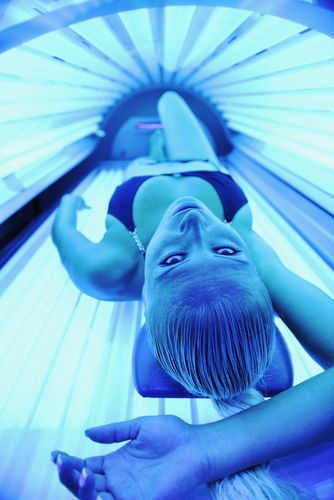FDA's New Tanning Bed Warning Labels Advise Youth Not To Use

In an effort to combat the most common cancer in the United States, new requirements will be made for the indoor tanning bed industry that may convert devoted fake-sun worshipers into avid sun-conscious sunscreen users. The Food and Drug Administration (FDA) is now requiring that all tanning beds and products associated with them carry warning labels that caution against people below the age of 18 years old using them. The health warning goes on to inform tanners that using the ultraviolet-lit beds will increase their risk of skin cancer.
“The FDA has taken an important step today to address the risk to public health from sunlamp products,” said Dr. Jeffrey Shuren, director of the FDA’s Center for Devices and Radiological Health, in a news release. “Repeated UV exposure from sunlamp products poses a risk of skin cancer for all users, but the highest risk for skin cancer is in young persons under the age of 18 and people with a family history of skin cancer.”
Tanning beds will also be reclassified from their previous “low-risk” to a more serious “moderate-risk” warning, which will require manufacturers to demonstrate product performance tests in order to receive FDA clearance for the sales of personal tanning beds. The decision, which was originally proposed May 2013, welcomed 90-days’ worth of comments. The initial proposal was based on a study by the American Academy of Dermatology (AAD), which found people who were exposed to UV radiation, had a 59 percent higher risk of melanoma, a deadly form of skin cancer.
Skin cancer is the most common cancer in the United States and according to the AAD, it is estimated that one in 50 Americans will develop melanoma in their lifetime; a frighteningly high statistic considering approximately 75 percent of skin cancer deaths are from melanoma. If the trend doesn’t slow down, by the end of this year, 9,710 people will die from melanoma.
One of the FDA warning labels will read: "Persons repeatedly exposed to UV radiation should be regularly evaluated for skin cancer."
Why are sunburns so dangerous?
Tanning causes the same skin damage whether it be from a man-made source or the sun. Sunburns are one of the most dangerous forms of cellular damage, and it’s important to realize that sunburn causes a certain type of skin damage that can stimulate precancerous and cancerous growth that requires surgical removal.
According to the Skin Cancer Foundation survey, 42 percent of people are sunburnt at least once a year. For those people, especially the ones that experience a blister, cancer risk factors increase dramatically. If you experience five sunburns, regardless of how old you are, the risk of developing melanoma will double.
Melanoma is the most serious and dangerous type of skin cancer, which can be deadly if not treated immediately. For those who have experienced just one blistering sunburn as a child or adolescent, the chances of developing melanoma later in life more than doubles.
"There's mounting evidence showing that indoor tanning in childhood and early adult life further increases risk of melanoma later in life due to greater lifetime exposure," Nancy Stade, deputy director for policy at the FDA's Center for Devices and Radiological Health, said in a press conference announcing the order.



























